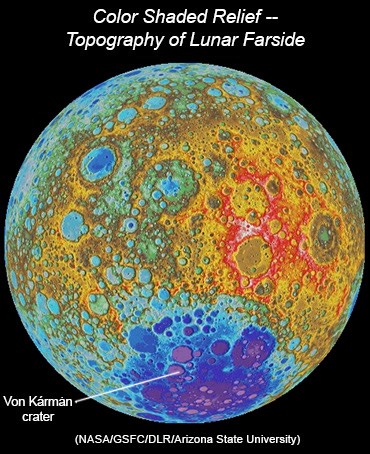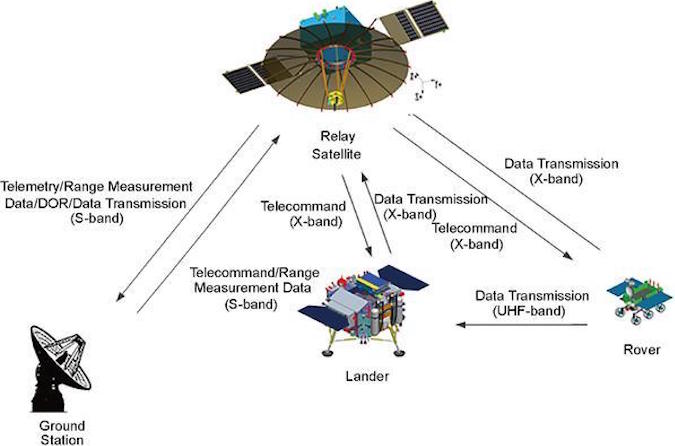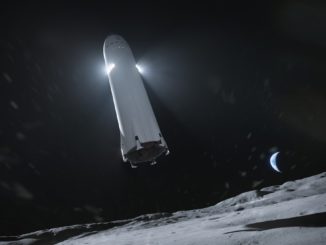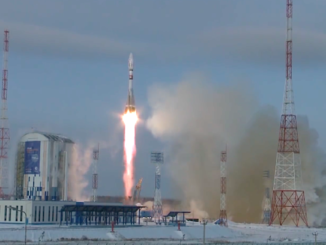
A robotic Chinese spacecraft named Chang’e 4 braked out of lunar orbit and slowed to a controlled touchdown on the far side of the moon Thursday, a first in the history of space exploration. The lander later deployed a small rover to explore the surrounding landscape.
The spacecraft landed at 0226 GMT on Jan. 3 (9:26 p.m. EST on Jan. 2) in the 110-mile-wide (180-kilometer) Von Karman crater, located in the southern hemisphere on the back side of the moon. Chinese websites released several images captured during the lander’s descent, and then revealed several more pictures taken of the mission’s six-wheeled rover as it drove down a ramp and onto the lunar surface.
But Chinese state television did not provide a live broadcast of the landing, and reporters and space enthusiasts were kept in the dark, waiting for basic updates released on Chinese Weibo social media accounts. Chinese media also released few updates on the mission since its Dec. 7 launch aboard a Long March 3B rocket.
Finally, after Chinese officials confirmed a successful landing, the country’s television news networks trumpeted the achievement in a series of broadcasts and feature stories. The state-run Xinhua news agency said the Chang’e 4 mission arrived at the targeted landing site at 10:26 a.m. Beijing time Thursday.
Overall, Chang’e 4 accomplished the 20th soft landing on the moon’s surface.
A press release from the China Aerospace Science and Technology Corp., or CASC, the government-owned prime contractor for the country’s space programs, said the Chang’e 4 spacecraft fired its liquid-fueled variable-thrust engine beginning at 0215 GMT at an altitude of around 9 miles (15 kilometers) above the moon. The lander slowed its horizontal velocity from 3,800 mph (1.7 kilometers) per second to close to zero, then changed its orientation to begin a vertical descent before settling to a soft landing on four legs cushioned against the shock of touchdown.
The far side of the moon is more rugged than the near side, so Chinese officials adjusted the descent trajectory for the Chang’e 4 mission to a more vertical profile from the curved profile used on Chang’e 3, China’s previous lunar lander which touched down on the near side in 2013.
“We chose a vertical descent strategy to avoid the influence of the mountains on the flight track,” said Zhang He, executive director of the Chang’e 4 probe project from the China Academy of Space Technology, said in a report published by the Xinhua news agency.
The Chang’e 4 spacecraft’s downward-facing camera took pictures of the landing zone from an altitude of around 6,500 feet — or 2 kilometers — to identify large obstacles such as boulders or craters. The lander paused its automated descent at around 330 feet (100 meters) in altitude to search for smaller obstacles and measure slopes on the surface, then used hazard avoidance algorithms to identify the safest place to set down, according to Xinhua.
Chang’e 4 took the first picture from the surface of the far side of the moon at around 0340 GMT on Jan. 3 (10:40 p.m. EST on Jan. 2), showing a small crater in the foreground.

The mission’s rover was named Yutu 2, after the mobile robot named Yutu that flew on the Chang’e 3 mission to the moon in 2013. Yutu means “jade rabbit” in Chinese, and is the name of the pet rabbit of the moon goddess Chang’e in Chinese folklore, the source of the name of China’s lunar missions.
Chang’e 4 uses spare hardware built for the Chang’e 3 lunar lander and rover.
The Yutu rover ceased driving a few weeks after landing, but some of the craft’s instruments continued to function for a couple of years, and the stationary lander — a carrier module that delivered the rover to the lunar surface — was still operating last year, according to an update issued by Chinese officials at the time. Chang’e 3’s Yutu rover was designed to drive up to 6 miles (10 kilometers), but it traveled only 374 feet (114 meters) before losing its mobility due to a hardware failure, according to Chinese scientists.
The Yutu 2 rover is “lighter, smarter, stronger and more reliable” than is predecessor, Xinhua reported.
“How to solve that problem so that it won’t happen again was the main challenge in developing the new rover,” said Zhang Yuhua, a deputy chief designer of the probe, in a story published by Xinhua.
“We have improved the layout of the wires on the new rover and taken measures to prevent short circuits. We also made a fault isolation design so that if a problem occurs, it will not affect the whole system,” said Sun Zezhou, chief designer of the Chang’e 4 probe, according to Xinhua.
The Yutu 2 rover disembarked from the Chang’e 4 lander at 1422 GMT (9:22 a.m. EST) on Jan. 3, according to CASC.
“There are plenty of successful missions with successful landings on the near side of the moon, including Chang’e 3 in Mare Imbrium,” said Jun Huang from the Planetary Science Institute at the China University of Geosciences, in a presentation to U.S. scientists in March at the Lunar and Planetary Science Conference in Texas. “This mission has lasted for nearly five years, and it increased our knowledge about the moon greatly, however, we don’t have (until Chang’e 4) a mission dedicated to taking precision mesurements of the far side of the moon.”
There are some key differences between Chang’e 3 and Chang’e 4. For example, the Chang’e 4 mission does not carry a robotic arm or an Active Particle X-ray Spectrometer, an instrument capable to measuring the chemical elements in lunar rocks and soil.
In addition to a suite of cameras on both the stationary lander and rover, the Chang’e 4 mission delivered a new set of sensors to the lunar surface, some of which are provided by European scientists.
The roughly 2,600-pound (1,200-kilogram) landing module carries a low frequency radio spectrometer developed by Chinese scientists for astrophysics research. A German-developed neutron and dosimetry instrument on the stationary lander will measure radiation levels at the Chang’e 4 landing site, collecting data that could be useful in planning human exploration of the lunar far side, studying solar activity, and gauging the underground water content in Von Karman crater.
Chang’e 4’s Yutu 2 rover weighs around 297 pounds (135 kilograms), around 4 pounds (2 kilograms) lighter than Chang’e 3’s Yutu rover. The lighter weight is primarily driven by the removal of the robotic arm, officials said.

Yutu 2 hosts a ground-penetrating radar to study geologic layers buried under the landing site, and a visible and near-infrared spectrometer to gather data on soil composition. Chinese officials approved the addition of a Swedish instrument on the rover to study the interaction between the solar wind and the lunar surface, which is not shielded by an atmosphere from the bombardment of charged particles originating at the sun.
Chang’e 4 also delivered to the moon a student-designed carrier containing potato seeds and silkworm eggs. University students and scientists will monitor the growth of the organisms, which are housed inside a chamber and fed natural light and nutrients once on the lunar surface.
Speaking to an audience of U.S. scientists earlier this year, Jun said the biological experiment aboard Chang’e 4 is “quite unique and interesting.”
“There will be a micro-ecosystem inside,” Jun said. “There are some vegetables and worms, which I think will be a good astrobiological demonstration.”
Jun said the experiment to place seeds and eggs on the lunar surface could also help engage public interest.
Upgrades installed on the Chang’e 4 rover could allow it to reach the original design goal of Chang’e 3, which was to drive as far as 6 miles across the lunar surface, according to Jun.
Xinhua reported the Yutu 2 rover has a design life of three months, and is capable of driving over rocks as high as 8 inches (20 centimeters). Its top speed is roughly one-tenth of a mile per hour (200 meters per hour), and the rover will hibernate during the 14-day-long lunar night, the first of which will begin in mid-January.
Payloads aboard Chang’e 4 include experiments developed by at Harbin Institute of Technology, Zhongshan University, and Chongqing University of Science and Technology, according to the China National Space Administration.
“The soft landing and exploration of the far side, which has never been done before, will gain first-hand information about the terrain and lunar soil components and other scientific data, which will help enrich our understanding of the moon and the universe,” said Zhang He, executive director of the Chang’e 4 probe project, in a report published by Xinhua.
Chang’e 4’s landing site is located at 177.6 degrees east longitude and 45.5 degrees south latitude, officials said.

Scientists believe the far side of the moon is covered with more ancient terrain than the near side, and U.S. teams have proposed for NASA to dispatch a robotic mission to a location in the South Pole-Aitken basin region — near Chang’e 4’s landing site — to scoop of samples and bring them back to Earth. The South Pole-Aitken basin region covers a large swath of the moon’s far side southern hemisphere, and is believed by scientists to be one of the most ancient impact sites in the solar system, created when a large asteroid or comet struck the moon.
A sample return mission to the region could date the impact, and help scientists study how the Earth and moon were bombarded by smaller objects billions of years ago, said Bradley Jolliff, a geologist at Washington University in St. Louis who has proposed such a mission to NASA for funding through the space agency’s New Frontiers line of interplanetary missions.
But NASA has not approved development of such a mission to the moon’s far side, and the only U.S. spacecraft currently exploring the moon is the Lunar Reconnaissance Orbiter, which has circled the moon since 2009. LRO is scheduled to fly over the Chang’e 4 landing site in late January, and its camera could be able to spot the lander on the surface.
The first images of the moon’s far side were returned by the Soviet Union’s Luna 3 probe in 1959, and the first humans to see the far side were the Apollo 8 astronauts, which orbited the moon in December 1968.
Jim Bridenstine, NASA’s administrator, tweeted his congratulations on China’s successful landing.
“Congratulations to China’s Chang’e 4 team for what appears to be a successful landing on the far side of the moon. This is a first for humanity and an impressive accomplishment!” Bridenstine wrote.
Special relay satellite launched to communicate with Chang’e 4
The moon is tidally locked with Earth, so the same side of the lunar surface always faces our planet. One of the critical challenges in sending a mission to the far side of the moon — the hemisphere that always faces away from Earth — is communications.
China launched a dedicated relay satellite named Queqiao in May to pass off signals between ground controllers in China and the Chang’e 4 spacecraft when it is outside of direct radio contact. Queqiao, which means “magpie bridge” in Chinese, flew into a “halo orbit” around an Earth-moon gravitational balance location — called a Lagrange point — around 40,000 miles (65,000 kilometers) beyond the moon.
At that location, the combined effect from gravity from Earth and the moon keeps Queqiao at roughly the same distance as the moon completes each 28-day orbit around our planet.

Chang’e 4 is the final planned mission in the second phase of China’s lunar exploration program. China’s first lunar mission — Chang’e 1 — launched in 2007 and surveyed the moon from lunar orbit for more than a year before impacting the surface in 2009. The Chang’e 2 orbiter launched in 2010, explored the moon several months, then flew to a more distant libration point and escaped the Earth-moon system to fly by an asteroid in 2012, another first for China’s space program.
Following the Chang’e 3 and Chang’e 4 lunar lander missions, China plans to launch the Chang’e 5 spacecraft in late 2019 to land on the near side of the moon, collect samples and return the specimens to Earth. The sample return mission would be the first to return material from the lunar surface to Earth since the Soviet Union’s Luna 24 mission in 1976.
China launched a prototype re-entry capsule on a trajectory around the moon and back to Earth in 2014 to test the ship’s ability to withstand re-entry into the atmosphere on a return from deep space, which subjects the spacecraft to higher speeds and hotter temperatures than a re-entry from low Earth orbit. The Chang’e 5 T1 precursor mission was a success.
A follow-up mission named Chang’e 6, using spare components from Chang’e 5, could attempt a sample return from the far side of the moon in the early 2020s, and China is developing long-range plans to send humans to the moon in the 2030s.
China is also working on a Mars rover for launch in 2020.
China’s growing push for international collaboration in space
The inclusion of instruments on Chang’e 4 from Kiel University in Germany and the Swedish Institute of Space Physics marks the first time international payloads have flown to the lunar surface on a Chinese lander.
China’s Queqiao data relay craft also carries an international science payload. Dutch scientists developed a low-frequency radio receiving flying on Queqiao to study how future missions heading to the far side of the moon could be used for astronomical observations, taking advantage of a “radio quiet” interference-free zone where the moon blocks natural and human-made radio emissions from the sun and Earth.
Two tech demo microsatellites also launched with Queqiao earlier this year, each with their own radio astronomy payloads and optical cameras from Saudi Arabia. One of the small spacecraft reportedly failed to enter lunar orbit, but the other successfully arrived at the moon and beamed imagery back to Earth.
Zhang Kejian, head of the China National Space Administration, or CNSA, said in October that the Queqiao relay satellite could be used by future lunar missions by other countries to the moon’s far side. Zhang also announced at the International Astronautical Congress in Bremen, Germany, that an extra 22 pounds, or 10 kilograms, of payload capacity will be available on the Chang’e 6 mission for small instruments provided by institutions outside China.
There will also be opportunities for international science experiments on China’s space station, scheduled to be completed in 2022, Zhang said.
“We welcome international participation by using the Chinese space station for scientific research,” Zhang said in October. “The Mars and planetary missions of CNSA are being also implemented, and we look forward to having international cooperations in this particular area.”

While space agencies in Europe are looking to expand partnerships with China’s space program, NASA is banned by law from bilateral cooperation with China in space exploration. A provision inserted by former Rep. Frank Wolf, R-Virginia, in a NASA funding act in 2011 — and still in effect — prohibits the space agency from most forms of collaboration with China, such as direct agreements to support missions led by each nation.
At the same space industry meeting in Bremen, the head of NASA said he is concerned about China’s military space efforts, but added that the space agency is open to expanded cooperation with the Chinese space program.
“From a U.S. government perspective, it is a concern,” Bridenstine said, referring to China’s advancing military space capabilities, and the blurred boundaries between the country’s civilian and military space programs. “From a NASA perspective, we’ll do whatever the U.S. government permits us to do in order to cooperate where there are common interests, and there are areas where there are common interests.”
Data-sharing between U.S. and Chinese scientists continues, and some non-governmental institutions have arranged technical dialogs and data exchanges between top researchers working on NASA and Chinese space missions.
“Where we can cooperate is on data, and they’re doing some amazing scientific experiments,” Bridenstine, a former congressman from Oklahoma, told reporters in October. “They are flying to the far side of the moon, and the United states is doing some amazing scientific experiments, and we can share data and collaborate that way, so each country can learn even more about science. This could be the first confidence-building measure that is necessary to establish the kind of relationship that’s necessary to go to the next step.”
Bridenstine also emphasized the importance for all space powers, including China, to work together on limiting space debris in Earth orbit, and ensuring satellites do not collide or interfere with each other in space.
“There is no issue on the face of the planet, as it relates to space, more important for all of us to get right than that issue,” Bridenstine said. “We need to preserve the space environment for generations to come, and the only way we’re going to be able to do that internationally is to collaborate in mitigation, and ultimately space situational awareness and space traffic management, and even remediation of orbital debris. So I think there are ways we can collaborate.”
“We do collaborate already,” Bridenstine said. “I think there are more ways to collaborate, but we do need to build confidence so we can do even more in the future.”
Email the author.
Follow Stephen Clark on Twitter: @StephenClark1.



